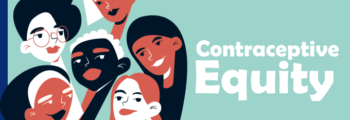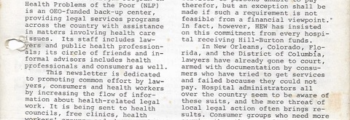The National Health Law Program has been protecting and advancing the health care rights of low-income individuals for more than 50 years. We began in 1969 as legal “backup center” in Los Angeles, and over the years have grown into multi-state team of 40+ lawyers and advocates.
This timeline details the evolution of the National Health Law Program and the issues we have addressed over the last half-century. From enforcement of the Civil Rights Act of 1964 and protection of reproductive rights, to issues of language access and the Affordable Care Act, the National Health Law Program has grown and changed with the pressing legal issues of the moment, and continues to do so today.
Our timeline is a work in progress, and we are adding to it as we talk with a variety of stakeholders over the course of our 50th anniversary. If you know of a milestone you’d like to recommend for the timeline, please reach out to our Director of Communications, Andy DiAntonio.
1964 – The Civil Rights Act

President Lyndon Johnson enacts the Civil Rights Act of 1964 which outlaws discrimination based on race, color, religion, sex, or national origin. The law prohibits unequal application of voter registration…
Read more1965 – The Medicare and Medicaid Act

On July 30, 1965, President Lyndon B. Johnson signed into law the Social Security Act Amendments, popularly known as the Medicare bill. It established Medicare, a health insurance program for…
Read more1969 – Founding the National Health Law Program

The National Health Law Program (then named National Legal Program on Health Problems of the Poor) was founded by Ruth and Milton Roemer at the University of California, Los Angeles…
Read more1973 – Doe v. Bolton: The Fight for Reproductive Health

In 1973, the National Health Law Program submitted an Amicus brief to the Supreme Court in the case Doe v. Bolton, a companion case to Roe v. Wade, which was…
Read more1974 – Florida Peach Growers Association v. Department of Labor: Protecting the Safety Rights of Workers

In 1970, Congress established the Occupational Safety and Health Administration (OSHA) to “assure safe and healthy working conditions for working men and women by setting and enforcing standards and by…
Read more1974 – Doe v. Westby: Fighting for Reproductive Rights in Medicaid

Following Roe, states across the nation grappled with how to integrate the right to abortion into their Medicaid programs. In South Dakota, officials decided that low-income women did not have…
Read more1975 – Fighting for Transparency in Drug Pricing

While transparency in prescription drug pricing might seem like a modern health care concern, the National Health Law Program has been fighting for fairer drug pricing for decades. In 1975,…
Read more1975 – Washington, D.C. Office Opens

In 1975, the National Health Law Program opened a second office in Washington, D.C. The purpose was, and remains, to advance health policy work at the national level. Since 1975,…
Read more1976 – Advocating for Children’s Health and EPSDT

Enacted in 1967, Early and Periodic Screening, Diagnostic and Treatment (EPSDT) is the child health component of Medicaid. EPSDT added to Medicaid a deliberate focus on prevention and early intervention…
Read more1986 – Ending Hospital “Dumping”

The Federal Emergency Medical Treatment and Labor Act, also known as EMTALA or the Patient Anti-Dumping Law, was enacted by Congress in 1986 to stop hospitals that receive federal funds…
Read more1989 – Working Toward Comprehensive Lead Screening

In 1989 northern California was hit by the massive Loma Prieta earthquake, which left 63 dead and 3,757 injured. In the aftermath of the quake and subsequent cleanup, it was…
Read more1990 – Protecting the Civil Rights of People with Disabilities

The Americans with Disabilities Act of 1990 (ADA) is a civil rights law that prohibits discrimination based on disability. It affords similar protections against discrimination to Americans with disabilities as…
Read more1991 – Challenging Abuse to Title VI of the Civil Rights Act

In an attempt to scare and harass members of the immigrant community in southern Texas, the McAllen Medical Center equipped their security guards with uniforms that were identical to the…
Read more1993 – Carrboro, North Carolina Office Opens

In 1993 the National Health Law Program opened a third office in North Carolina with Legal Director Jane Perkins at the helm. Over the years the North Carolina office has…
Read more1997 – The Children’s Health Insurance Program

The Children’s Health Insurance Program (CHIP) is a program administered by the U.S. Department of Health and Human Services that provides matching funds to states for health coverage to families…
Read more1999 – Fighting for Language Access

In 1999 a Farsi speaking women fell out of her bed at the Maine Medical Center, and despite her cries for help, she was ignored by staff who later claimed…
Read more2006 – Lankford v. Sherman: Access to Durable Medical Equipment

Joey Everett was a high school student in rural Missouri who was involved in a car accident that left him paralyzed. He qualified for Missouri’s Medicaid program, but was denied…
Read more2010 – The Affordable Care Act

In 2010, President Barak Obama signed into law the Affordable Care Act, the largest overhaul of the U.S. health care system in the nation’s history. By 2016, the uninsured share…
Read more2011 – Katie A. v. Douglas: The Rights of Children to Access Mental Health Services

Medi-Cal, California’s Medicaid program, provides free or low-cost health care coverage to more than 14 million low-income adults, families with children, seniors, persons with disabilities, pregnant women, children in foster…
Read more2011 – Pashby v. Cansler: Fighting for Home-and-Community Based Care

Accessible, community-based, non-discriminatory health care coverage and services for individuals with disabilities are an essential component of any health care system. Yet individuals with disabilities face discrimination in both health…
Read more2014 – Advocacy for HIV/AIDS Therapy & Medication Coverage Under the ACA

Section 1557 of the Affordable Care Act prohibits discrimination based on race, ethnicity, language, age, sex, disability, and immigration status. It was the first law to ban discrimination in health…
Read more2014 and Beyond – Contraceptive Equity Act

Contraceptive equity is a policy framework under which contraceptive care is easily accessible and covered at no cost in all health programs. It is of paramount importance because of the…
Read more2017 – The Fight to Save the Affordable Care Act

In the summer of 2017, the National Health Law Program, in coordination with dozens of partner organizations, engaged in a public, grass-roots campaign to stop congressional attempts to repeal and…
Read more
